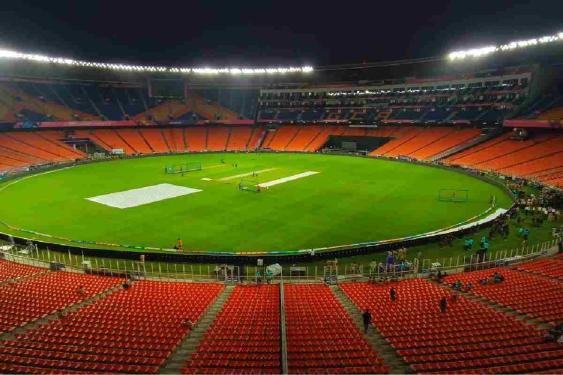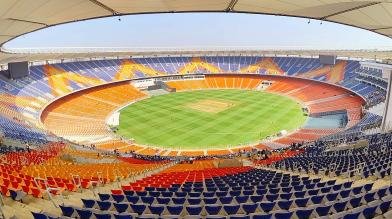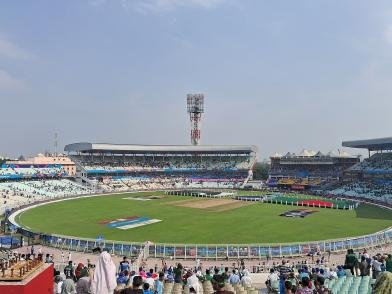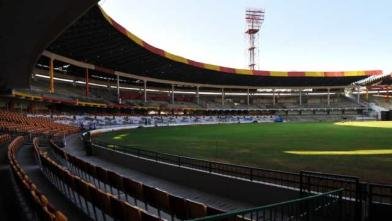❤️ A Cricketing Jewel in Punjab’s Crown
Nestled in the vibrant heart of Mullanpur, near Chandigarh, the Maharaja Yadavindra Singh International Cricket Stadium stands as a beacon of Punjab’s rich cricketing legacy and modern ambition. This state-of-the-art venue, home to the Punjab Kings in the IPL, pulses with the energy of passionate fans, echoing with chants that reverberate against the backdrop of the Shivalik Hills. Named after the revered Maharaja Yadavindra Singh, a royal patron of cricket, the stadium blends heritage with cutting-edge facilities. From its lush outfield to its electrifying atmosphere during IPL clashes, this cricketing fortress captures the spirit of Punjab’s love for the game, offering an unforgettable experience for matchgoers, fantasy players, and cricket enthusiasts alike.
History of the Stadium
- Year of Establishment
The Maharaja Yadavindra Singh International Cricket Stadium, also known as the New Punjab Cricket Association (PCA) Stadium, was established in 2021, with its construction beginning in 2017. Officially inaugurated in 2020, it marked a new chapter for Punjab’s cricketing infrastructure, replacing the older IS Bindra PCA Stadium in Mohali as the primary venue for the Punjab Kings in the IPL.
- Key Renovations
Since its inception, the stadium has not required significant renovations due to its recent construction. However, ongoing enhancements include upgrades to fan amenities, such as additional food courts and improved accessibility features for differently-abled spectators. The Punjab Cricket Association continues to invest in maintaining the stadium’s world-class standards, with plans for future expansions like AR fan experiences and a cricket museum.
- Founding Visionaries
The Punjab Cricket Association spearheaded the project in March 2010, envisioning a world-class facility to elevate Punjab’s cricketing stature. The stadium, built at an estimated cost of ₹230 crore (US$29 million) across 41.95 acres, was designed to meet ICC standards. It was named in honor of Maharaja Yadavindra Singh, the ninth and last ruling Maharaja of Patiala, celebrated for his contributions to Indian cricket.
- Iconic Historic Matches
While the stadium is yet to host international Test or ODI matches, it made its IPL debut in 2024 with a thrilling encounter between Punjab Kings and Delhi Capitals on March 23. The venue has hosted domestic tournaments like the Syed Mushtaq Ali Trophy (2022–2023), known for low-scoring T20 affairs, and is confirmed to host the Women’s ODI World Cup final in 2025, cementing its growing significance.
- Role in India’s Cricketing Evolution
The stadium represents Punjab’s ambition to become a global cricketing hub. By hosting IPL matches and domestic tournaments, it nurtures local talent through training camps and academies while attracting international attention. Its eco-friendly design and modern infrastructure position it as a model for future cricket venues in India, contributing to the sport’s growth in the region.
Location and Accessibility
- Full Address
Maharaja Yadavindra Singh International Cricket Stadium, Mullanpur, Tira, Punjab 140901, India.
- Distance from Airport/Train/Bus Stations
- Chandigarh International Airport: Approximately 25 km, a 40–50-minute drive depending on traffic.
- Chandigarh Railway Station: Around 20 km, roughly a 30–40-minute drive.
- Chandigarh Bus Stand (Sector 43): About 18 km, a 25–35-minute journey by road.
- Mullanpur Metro Station: Just 1 km away, a 10–15-minute walk or a quick auto-rickshaw ride.
- Nearby Landmarks
- Shivalik Hills: A scenic backdrop visible from the stadium.
- Sukhna Lake: A popular Chandigarh attraction, 22 km away.
- Rock Garden: A cultural landmark, approximately 20 km from the stadium.
- Chandigarh City Centre: 15 km, offering shopping and dining options.
- Metro, MRTS, Cab, Parking Info
The stadium is well-connected via Mullanpur’s metro station, making public transport a convenient option. Cabs and auto-rickshaws are readily available through apps like Ola and Uber. Ample parking (₹200–₹500 for cars/bikes) accommodates thousands of vehicles, with designated spaces for differently-abled fans. Shuttle services operate on match days for hassle-free access.
- Travel Tips for Fans on Match Days
- Book Transport Early: Pre-book cabs or use the metro to avoid match-day congestion.
- Arrive Early: Gates open 2–3 hours before matches; early arrival ensures smooth entry.
- Carry Essentials: Bring water bottles (sealed), sunscreen, and light snacks, as security checks are thorough.
- Check Weather: Summers in Mullanpur can exceed 40°C; dress lightly and stay hydrated.
Architecture and Design
- Seating Capacity and Layout
The stadium boasts a seating capacity of 30,000–40,000, with estimates varying between sources (30,000+ to 38,000). It features three-tier stands, corporate boxes, and spacious concourses for unobstructed views and fan comfort. The layout is oval-shaped, adhering to ICC standards, with VIP lounges and media centers enhancing the premium experience.
- Pavilion Names and Dedications
While specific pavilion names are not widely documented, the stadium honors Maharaja Yadavindra Singh, reflecting Punjab’s royal heritage. Stands are designed for accessibility, with dedicated sections for differently-abled fans and premium corporate boxes for high-profile guests.
- Pitch Structure and Boundary Sizes
The pitch is sand-based, a departure from traditional soil, offering better stability but requiring meticulous maintenance. Boundary lengths range from 65–75 meters, with straight boundaries longer than square ones, favoring aggressive batting in T20 formats. The lush outfield ensures a fast-playing surface.
- Engineering/Design Elements
The stadium features a herringbone drainage system, clearing water within 25–30 minutes of rain, ensuring minimal match disruptions. High-efficiency floodlights support day-night games, while eco-friendly elements like solar panels and rainwater harvesting align with sustainable design. The architecture prioritizes fan experience with modern amenities and unobstructed sightlines.
Famous Matches and Events
- Historic Tests, ODIs, IPL Finals
The stadium has not yet hosted Test or ODI matches but is set to stage the Women’s ODI World Cup final in 2025. In IPL 2024, it debuted with Punjab Kings vs. Delhi Capitals on March 23, followed by high-octane clashes like PBKS vs. Rajasthan Royals. The IPL 2025 Qualifier 1 (PBKS vs. RCB) saw RCB chase 101 in 10 overs, showcasing the venue’s thrilling potential.
- Record-Breaking Innings or Bowling Spells
- Highest Team Total: Rajasthan Royals’ 205/4 in IPL 2024.
- Lowest Team Total: Punjab Kings’ 95 all-out.
- Highest Individual Score: Suryakumar Yadav’s 78.
- Best Bowling Figures: Arshdeep Singh’s 4/29.
- Most Wickets: Harshal Patel with 11 wickets in Mullanpur.
- Iconic Moments or Crowd Reactions
The electric atmosphere during PBKS’s IPL 2024 debut match, with fans chanting for their home team, set the tone for Mullanpur’s vibrant crowd culture. The 2025 Qualifier 1 clash, where RCB’s swift chase stunned spectators, remains a highlight, with fans describing it as “a carnival of cricket.”
Facilities
- Food, Water, Restrooms
Multiple food courts offer local delicacies like Amritsari kulcha and lassi, alongside standard stadium fare (burgers, pizzas). Drinking water stations are plentiful, and clean restrooms are strategically placed across concourses.
- AC Boxes, VIP Stands, Media Boxes
The stadium features air-conditioned corporate boxes and VIP lounges with premium seating and catering. A dedicated media center supports journalists with high-speed Wi-Fi and advanced broadcasting facilities.
- Player Amenities
Spacious dressing rooms, modern practice nets, and coaching academies cater to players’ needs. The Punjab Kings have praised the bounce-friendly pitch and top-notch facilities during IPL training camps.
- Accessibility for Disabled Fans
Ramps, dedicated seating, and accessible restrooms ensure inclusivity. Staff assistance and priority parking further enhance the experience for differently-abled spectators.
- Security and Crowd Management
Robust security includes CCTV surveillance, bag checks, and trained personnel. Crowd management is streamlined with clear signage, multiple entry/exit points, and shuttle services to prevent congestion.
Unique Features
- Pitch Uniqueness
The sand-based pitch is batting-friendly, with good pace and bounce, ideal for high-scoring T20 games. Spinners gain grip as matches progress, while pacers find early movement.
- Cultural or Fan Traditions
Punjab Kings’ fans bring a lively spirit, with chants and drumbeats creating a festive vibe. The stadium’s proximity to Chandigarh’s cultural hubs adds a Punjabi flair, with fans often celebrating with bhangra-inspired cheers.
- Eco-Friendly Policies, Design Innovations
The stadium incorporates solar panels, rainwater harvesting, and zero-discharge waste management, setting a benchmark for sustainability. Plans for AI-powered crowd analytics and AR fan zones highlight its futuristic vision.
- Iconic Chants, Stadium Sounds, Visuals
The roar of “Punjab di shaan!” echoes during PBKS matches, amplified by laser shows and a robust sound system. The floodlit stadium against the Shivalik Hills creates a stunning visual spectacle.
Ticket Booking
- Where to Book
Tickets for IPL and other matches are available on platforms like BookMyShow, Paytm, and the official IPL website. The PCA’s official site also provides booking links.
- Pricing Tiers
- General Stands: ₹800–₹2,000
- Premium Stands: ₹3,000–₹6,000
- VIP/Corporate Boxes: ₹10,000–₹25,000 Prices vary based on match significance (e.g., IPL playoffs vs. league games).
- In-Person vs. Online Options
Online booking via BookMyShow or Paytm is recommended for convenience. In-person tickets are available at the stadium’s box office, but long queues are common on match days.
- Best Tips for IPL or World Cup Games
- Book early for high-demand matches like IPL playoffs or the 2025 Women’s ODI World Cup final.
- Opt for premium stands for better views and amenities.
- Check refund policies for rain-affected games.
- Use official platforms to avoid scams.
Fan Experience
- Crowd Behavior and Atmosphere
The Mullanpur crowd is passionate, with fans creating an electrifying atmosphere through chants, drums, and colorful banners. IPL matches see a sea of Punjab Kings’ red and silver, with families, students, and cricket aficionados uniting for the spectacle.
- Best Stands for Viewing
- Premium Stands: Offer unobstructed views and proximity to the action.
- Upper Tiers: Ideal for panoramic views of the field and Shivalik Hills backdrop.
- Corporate Boxes: Perfect for luxury and comfort.
- Memorable Fan Quotes or Reviews
- “The energy here is unreal—like a Punjabi festival meets cricket!” – Rohan, IPL 2024 attendee.
- “Watching RCB chase 101 in 10 overs was insane; the crowd was on fire!” – Priya, 2025 Qualifier 1 spectator.
- Tips to Enjoy the Full Experience
- Arrive early to soak in pre-match festivities like fan zones and laser shows.
- Wear team colors to blend into the vibrant crowd.
- Engage with local vendors for authentic Punjabi snacks.
- Stay hydrated and use covered stands to beat the heat.









